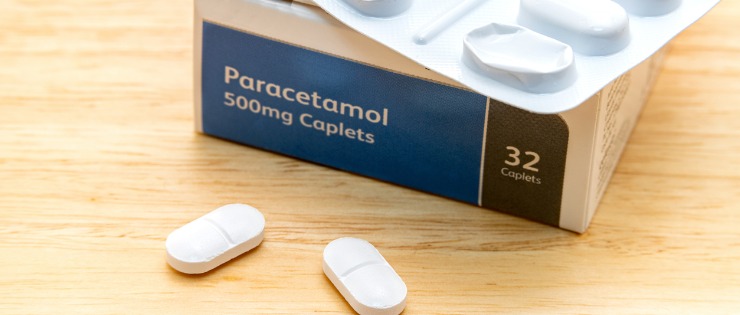
When pain hits, the first reaction for many people is to reach for an over the counter (OTC) drug. But is it paracetamol or ibuprofen you need?
Paracetamol and ibuprofen are common over the counter drugs used to treat mild to moderate pain caused by headache, period pain, arthritis, back or neck pain. Paracetamol is thought to mainly act centrally in the brain and the spine, while ibuprofen works mainly at the site of the pain.
What is Paracetamol?
Paracetamol is a pharmaceutical drug used to treat pain and fever. When mixed with other drugs such as codeine, it can treat strong pain, and when combined with antihistamines and decongestants, it can be used to treat colds and flu. Paracetamol has been available to the public since 1953 with a doctor’s prescription and a few years later was made available over the counter.
Paracetamol Uses
Paracetamol can be used to treat:
Headaches (e.g. migraines, tension headaches)
Muscle pain (e.g. strains and sprains, sport injuries)
Back pain
Toothaches
Muscle ache
Arthritis (including osteoarthritis)
Cold and flus
Fever
Paracetamol is available in tablets, capsules, soluble powders, liquids and suppositories.

How Does Paracetamol Work?
Paracetamol blocks the production of prostaglandins and COX enzymes in the body. These are the chemicals that promote pain, fever and inflammation. Paracetamol reduces the nerve transmission of pain signals and reduces fever as it acts centrally in the brain and spine. Paracetamol is processed in the liver.
Some paracetamol products are marketed as fast acting or rapid absorption. These medications contain sodium bicarbonate or caffeine, so they are absorbed faster to provide quicker pain relief.
Side Effects of Paracetamol
Side effects of taking paracetamol include drowsiness, fatigue, skin rashes and itchiness. Children may also experience low blood sugar and tremors.
Regular use has a range of potential side effects including tiredness, anaemia, liver and kidney damage, breathlessness and a blue tinge to fingers and lips.
It’s important to follow directions as overdose can cause abdominal pain, vomiting, liver problems, seizures, coma and death. Urgent medical advice should be sought if an overdose occurs. Death can occur up to four days after an overdose.
Paracetamol affects everyone differently depending on a person’s size, weight, combination of other drugs, the amount consumed and how often paracetamol is taken.
In Australia, paracetamol is the active ingredient in several brands including Dymadon®, Lemsip®, Panadol®, Panamax®, Tylenol®.

How Long Can I Take Panadol For?
Paracetamol products shouldn’t be used for more than a few days unless you’ve received medical advice that it’s safe to do so. Prolonged use can be harmful, so if the pain or fever hasn’t subsided within a few days, you should seek medical advice.
What is Ibuprofen?
Ibuprofen is a non-steroidal anti-inflammatory drug (NSAID) used to treat moderate pain, fever, inflamed tissue, rheumatoid arthritis and back pain. Ibuprofen is available in tablets, capsules, soluble powders, liquids and suppositories.
Ibuprofen can be used to treat:
Headaches e.g. migraines or tension headaches
Sinus pain
Toothache
Backache, muscular aches and pains
Period pain
Sore throat
Arthritis
Joint or tendon sprains and strains
Ibuprofen is the active ingredient in Brufen® and Nurofen®. Ibuprofen and codeine are combined in the drug Nurofen Plus® to treat severe pain.

How Does Ibuprofen Work?
Ibuprofen reduces the body’s ability to produce cyclooxygenase (COX)-1 and COX-2. The body releases these substances in response to illness and injury promoting pain, inflammation and fever. You should notice a reduction in pain within 20-30 minutes after taking ibuprofen orally. Ibuprofen is processed in the kidneys.
Side Effects of Ibuprofen
The side effects of ibuprofen include dizziness, drowsiness, fatigue, ear ringing, blurred vision, eye irritation, fluid retention, abdominal pain, vomiting, diarrhoea, bladder irritation, tingling or numbness in the hands and feet, thirst and sweating.
Urgent medical attention should be sought if side effects include asthma or shortness of breath, swelling of the face or neck, dark colour vomit or black stools. There are extra risks in taking ibuprofen when you are aged over 65 years, have reflux or a stomach ulcer.

Who Shouldn’t Take Ibuprofen?
Ibuprofen has the potential for more side effects than paracetamol and needs to be avoided by a larger proportion of the community. If you’re over the age of 60, have any of these conditions or are taking these medications, you should speak to your GP before taking ibuprofen:
Stomach illness or ulcers
Heartburn or abdominal pain
High blood pressure
Any bleeding problems
Taking anticoagulants
Shingles or chickenpox
Crohn’s disease or ulcerative colitis
Heart disease
Kidney disease
Liver condition
Taking a diuretic
Taking any other NSAIDs
Other serious conditions
Pregnant or breastfeeding mothers
Is Ibuprofen Better Than Paracetamol?
It depends what you’re taking the medicine to treat. If it’s inflammation, then Ibuprofen is better than paracetamol, but if it’s mild pain then both ibuprofen and paracetamol will work.
Is Paracetamol and Ibuprofen Safe for Children?
Both drugs are suitable for children in the correct dose.
Does Paracetamol or Ibuprofen Need to Be Taken With Food?
Paracetamol and ibuprofen may be taken with or without food.
The advice around consuming food with these drugs has changed. The Australian Medicines Handbook (AMH) recommends taking the medication with water, but no food is required.
In previous advice in Australia and Europe, it was recommended that ibuprofen be taken with food to reduce the risk of stomach damage. However, there is little evidence to suggest that’s the case. Taking ibuprofen with water rather than food will provide faster pain relief. Peak concentrations of ibuprofen in blood occur between 1.5 to three hours after a 200mg dose in people when taken with a meal. If taken with just water, the maximum concentration is reached after 45 minutes. Having less food in the stomach may also reduce the need to take as much of the drug. But if you suffer an upset stomach after taking the medicine, try taking it with food or water next time.
People who take NSAIDs like ibuprofen for chronic, ongoing pain relief should see their doctor about the best way to avoid stomach damage. People who take NSAIDs for one month or more have a 2-4% of developing ulcers.

Dangers of Paracetamol and Ibuprofen
Too many people think that drugs bought over the counter aren’t dangerous. But consuming too much of the drug or in combination with other drugs can cause serious illness or death.
Damage to the Stomach Lining
Ibuprofen belongs to a class of medicines called non-steroidal anti-inflammatory drugs (NSAID). Chronic use of NSAID can damage the stomach lining and lead to gastritis and ulcers.
Accidental Overdose
Paracetamol was the most common over the counter drug to be misused in 2013. Teens between the ages of 14-19 are the most likely age group to misuse paracetamol and ibuprofen.
Between half and two-thirds of drug overdoses using paracetamol are unintentional. A lack of paracetamol knowledge causes accidental overdoses. Some people don’t understand the maximum daily dose, take multiple drugs without realising paracetamol is the active ingredient in them or don’t realise the risk of overdose because it’s sold over the counter.
If you suffer an adverse reaction to the medication, stop taking it and seek medical care.
Children are also at risk of overdose with parents not knowing how to measure the correct dose and a lack of knowledge about safe strengths. In recent years, many brands have introduced child safety packaging to make it more difficult for children to access the medication from blister packs. All medication should be kept out of reach of children.
It’s recommended that parents take their child to see a doctor if they have been taking paracetamol or ibuprofen for 48 hours and are still suffering pain or fever to determine the cause.

Taking Paracetamol and Ibuprofen Together
Adults are able to take the two drugs together as long as they don’t exceed the maximum recommended dose. But that can be difficult. There are no studies that show there is any benefit to alternating between the two so it’s easier to stick with the one.
The maximum doses for both drugs are:
The maximum daily oral dosage of paracetamol in adults and children older than 12 years is 500 to 1000 mg every four to six hours.
Tips for Staying Safe with OTC Painkillers
For most people taking an OTC pain killer on the odd occasion is relatively safe but there are a few things to keep in mind to avoid misuse.
Check the label for dosage directions even if you think you remember
Speak to your doctor if you have an ongoing illness or are taking other medications to find out which painkillers are suitable
Start with the lowest recommended dose
Understand that different brands may have different recommended doses
Never exceed the maximum recommended daily dosage
See your doctor if you have pain or fever after a few days